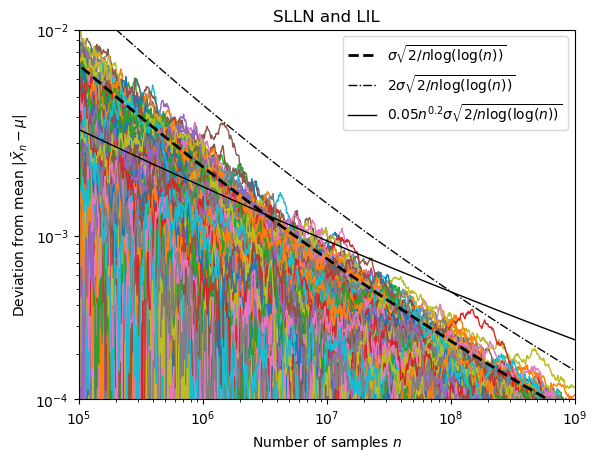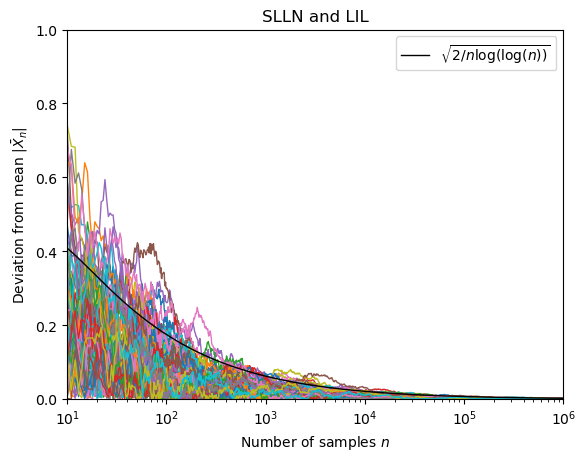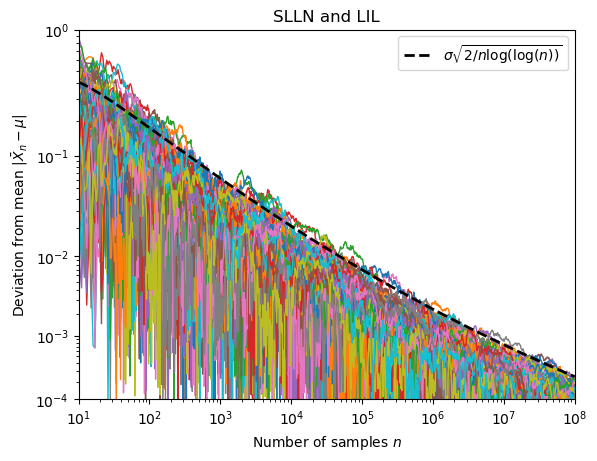The Law Of The Iterated Logarithm Expained And Visualised
In the first part of this post you will learn what the law of the iterated logarithm (in the following LIL) means. In the second part you will learn how to write a simple Python program to visualize the LIL and then how to optimize the program using Numba. You can find the Jupyter notebook with the code here on my Github.
The Law Of The Iterated Logarithm
This section will adress what the LIL says and what it means for pratical purposes. First some notation: $X$ will denote a sequence of identically and independantly distributed real valued random variables with finite mean $\mu$ and variance $\sigma^2$. The $n$-sample mean $\bar{X}_n $ of $X$ is defined by $\bar{X}_n = n^{-1} \sum_{i=1}^n X_i $.
The SLLN states that $\bar{X}_n $ converges to $\mu$ almost surely (from now on a.s.) as $ n \to \infty$.
But it does not tell us how fast $\bar{X}_n $ converges to $\mu$. This is where the LIL comes in. Define a sequence of real numbers $l$ by \begin{equation} l_n=\sigma \sqrt{2/n \log ( \log ( n))} \quad \text{for} \ n > e \end{equation} Note that $\lim_{n \to \infty } l_n =0$. Then the LIL says that \begin{equation} \tag{1} \limsup_{n \to \infty} l_n^{-1} |\bar{X}_n - \mu|= 1 \quad \text{a.s.} \end{equation} Unravelling the definition this means that the following is true for $\forall \varepsilon >0$: \begin{equation} | \bar{X}_n - \mu| < (1 + \varepsilon )l_n \quad \text{a.s.} \end{equation} for all but finitely many $n$ and \begin{equation} (1 - \varepsilon ) l_n < | \bar{X}_n - \mu| \quad \text{a.s.} \end{equation} for infinitely many $n$. Using the big-$\mathcal{O}$ notation the LIL is therefore equivalent to saying that $|\bar{X}_n - \mu| = \mathcal{O}(l_n)$ a.s. as $n \to \infty$ with any bounding constant $>1$, but not with any bounding constant $<1$. So the LIL gives us an upper bound for the speed of convergence in the SLLN for large $n$. Furthermore the LIL also tells us that \begin{equation} \lim x_n^{-1} l_n^{-1} |\bar{X}_n - \mu| = 0 \quad \text{a.s.} \end{equation} for any sequence of positive real numbers $x$ that converges to $\infty$ (follows from the rules of the product of $\limsup$’s). In other words using the little-$o$ notation $\bar{X}_n - \mu = o(x_n l_n) $ a.s. as $n \to \infty$.
We can numerically visualize these relations by generating $X_1( \omega), X_2 (\omega) , \dots , X_N (\omega)$ for multiple outcomes ${ \omega_1, \dots, \omega_M } $ and then plotting both $l_n$ and $\bar{X}_n(\omega) -\mu$ for all $n \in {1 , \dots , N}$ and $\omega \in { \omega_1, \dots, \omega_M } $. The sequence $(\bar{X}_1(\omega) -\mu , \dots ,\bar{X}_N(\omega) -\mu)$ ($\omega$ fixed) is called a path in the following. This has been done for a standard normal distribution (mean 0, variance 1) with 800 paths to produce the following figure:

A logarithmic scale is used on the horizontal axis, while a 10-th root scale is used on the vertical axis. Each colored line is the path for one outcome. The dash-dotted line visualizes that $|\bar{X}_n - \mu| = \mathcal{O}(l_n)$ a.s. and the solid line that $|\bar{X}_n - \mu| = o(x_n l_n)$ a.s. with $x_n = n^{0.2}$. Also note how slow the sample mean really converges, even after using $10^9$ samples there are still deviations in the order of $10^4$ from the real mean.
Visualizing The Law Of The Iterated Logarithm In Python
This section will tell you how to write a python program to visualise the LIL as discussed in the preceding section and how to optimize it.
Basic Code
We will start with a simple python program.
The libary numpy will be used to do the heavy lifting, while matplotlib will be used for plotting:
import numpy as np
from matplotlib import pyplot as plt
The following function computes the values of M paths for a standard normal distribution (mean zero and variance 1) and returns their values for the $n$ in ns.
def generate_paths_basic(M,ns):
"""returns an array containing the values of M different paths at the values of n in ns"""
rng = np.random.Generator(np.random.SFC64()) #nitialize RNG
rand = rng.normal(size=(M,ns[-1])) #generate normal distributed data
paths = np.cumsum(rand,axis=1) #calculate the partial sums from n=1 to n=ns[-1]
return paths[:,ns-1] #only return the partial sums for those values of n in ns
We dont want to display the paths for all values of $n$. A logarithmic scale is a good idea:
X= np.logspace(1,6,base=10,num=1000) #create array of numbers between 10**1 and 10**6 that are equally that are evenly spaced on a log scale for plotting of the iterated logarithm
ns = np.unique(np.round(X).astype(np.int64)) #create array of integers between 10**1 and 10**6 that are equally spaced on a log scale for plotting of the paths
Lets generate 80 paths
paths = generate_paths_basic(80,ns)
and define the sequence $l_n$ to compare the paths with:
def iterlog(x):
if x<=np.e:
return 0.0
else:
return np.sqrt(2/x*np.log(np.log(x)))
iterlog = np.vectorize(iterlog) #to make sure the function is employed element-wise on arrays
Finally we can visualize the results:
fig, ax = plt.subplots()
ax.plot(X,iterlog(X),color="black",lw =1,zorder=5,label=r"$\sqrt{2 /n \log ( \log (n))}$") #plot the iterated logarithm
for path in paths:
ax.plot(ns,np.abs(path/ns),lw=1) #plot the path
ax.set_xlabel("Number of samples $n$")
ax.set_ylabel(r"Deviation from mean $|\bar{X}_n |$")
ax.set_xscale("log")
ax.set_xlim(ns[0],ns[-1])
ax.set_ylim(0,1)
plt.legend()
plt.title("SLLN and LIL")
plt.show()

Optimizing The Code Using Numba
This section tells you how to optimize the above code to deal with large numbers of samples.
In the process you will learn to write fast python code that leverages parallel computation with numba.
So lets get into it:
While the above code is very simple and executes relatively fast it has a big problem if we want to calculate the paths for even larger $n$:
It uses way too much ram.
This is because the function generate_paths_basic creates two huge arrays to store the random data and the partial sums in.
Of course we dont really need to generate all random data at once and store it in an array.
We also dont need to store all values of the paths.
Instead we only need to store the values of the paths that we want to display and we can generate random numbers as we are using them.
So lets optimize the code with the goal not to waste ram. While we are at it we can also add multi-threading.
To facilitate this we will be using the numba and the threading module.
import numpy as np
from matplotlib import pyplot as plt
import numba as nb
import threading
The following function will be used to calculate the path differences between values of $n$ that we are interested in.
@nb.jit(nopython=True,fastmath=True,nogil=True)
def partial_sum(rng,n):
"""take an instance rng of the np.random.Generator() class and sum n normally distributed samples drawn from rng"""
var=0
for i in range(n):
var+=rng.normal()
return var
We are using the @nb.jit decorator to tell numba to treat the function to make it fast.
We pass an instance of the np.random.Generator() class to use it within the numba’d function (this only works because there is explicit support for this in numba).
This function has the advantage of not saving intermediate results and not creating large arrays (unlike using numpy would).
The usage of numba is critical, because the same code using vanilla python would run very slow and would be restricted from multi-threading by the python GIL.
We can use the partial_sum function to define a function that calculates the values of the paths at those $n$ in ns:
@nb.jit(nopython=True,fastmath=True,nogil=True)
def generate_paths(paths,rng,ns,diffs):
"""takes an array paths and writes the relevant path values in it for paths.shape[0] different paths. Uses random samples from rng."""
for j in range(paths.shape[0]):
paths[j,0]=partial_sum(rng,ns[0])
for ind,val in enumerate(diffs):
paths[j,ind+1] = partial_sum(rng,val)+paths[j,ind]
and use it to do multi-threading:
def generate_paths_mt(M,threadnr,ns):
"""generate M paths (M is expected to be an integer multiple of threadnr) using threadnr different threads returning an array containing the values of the paths for those n in ns"""
paths = np.empty(shape=(M,len(ns))) #array to save the values of the paths
diffs = np.diff(ns) #array of differences in ns i.e. diffs[i] = ns[i+1]-ns[i]
chunk_len = paths.shape[0]//threadnr #number of paths each thread calculates
chunks = [paths[i*chunk_len:(i+1)*chunk_len,:] for i in range(threadnr)] #one slice of the paths array for each thread to execute generate_paths on
rngs = [np.random.Generator(np.random.SFC64()) for i in range(threadnr)] # one rng for each thread
threads = [threading.Thread(target=generate_paths,args=([chunks[i],rngs[i],ns,diffs])) for i in range(threadnr)] #create the threads
for thread in threads:
thread.start()#start the thread
for thread in threads:
thread.join()#wait for the thread to finish
return paths
There are two things worthy of notice here: Firstly the RNG that we are using is not thread-safe, therefore every thread must have their own RNG.
Secondly this form of multi-threading only speeds up computation because we call functions that haven been numba’d with the nogil=Trueoption circumventing the Python GIL.
Lets use this function to generate 80 paths with a large number of samples:
X= np.logspace(1,8,base=10,num=1000) #create array of equally spaced numbers on log scale for plotting of the iterated logarithm
ns = np.unique(np.round(X).astype(np.int64)) #create array of equally spaced integers on log scale for plotting of the paths
paths = generate_paths_mt(80,8,ns)
To visualise the data we proceed as before (the function iterlog is defined as in the preceding section).
The only changes are to add a 10-th root scale for better visibility of the data and to add some fancy ticks and tick labels.
fig, ax = plt.subplots()
ax.plot(X,iterlog(X),color="black",lw =2,ls="--",zorder=5,label=r"$ \sigma \sqrt{2 /n \log ( \log (n))}$") #plot the iterated logarithm
for p in paths:
ax.plot(ns,np.abs(p/ns),lw=1) #plot the path
ax.set_xlabel("Number of samples $n$")
ax.set_ylabel(r"Deviation from mean $|\bar{X}_n - \mu|$")
ax.set_xscale("log")
ax.set_xlim(ns[0],ns[-1])
def f(x):
return x**(1/10)
def g(x):
return x**10
ax.set_yscale("function", functions=(f, g))
ax.set_ylim(10**-4,10**0)
ax.set_yticks([ 10**(-1*i) for i in range(5)])
ax.set_yticks([(i+1)*10**(-1*j) for j in [1,2,3,4] for i in range(9) ],minor=True)
ax.set_yticklabels(["$10^{}$".format("{"+str(-1*i)+"}") for i in range(5)])
plt.legend()
plt.title("SLLN and LIL")
plt.show()

Performance Analysis
It is interesting to compare the performance of the two functions in a like for like scenario:
threadnr = 8
M = 10*threadnr #number of paths to calculate (expected to be integer multiple of the thread number)
X= np.logspace(1,6,base=10,num=1000) #create array of equally spaced numbers on log scale for plotting of the iterated logarithm
ns = np.unique(np.round(X).astype(np.int64)) #create array of equally spaced integers on log scale for plotting of the paths
First up a single thread vs single thread test:
%timeit paths = generate_paths_mt(M,1,ns) #using 1 thread to compare
723 ms ± 19 ms per loop (mean ± std. dev. of 7 runs, 1 loop each)
%timeit paths = generate_paths_basic(M,ns)
1.67 s ± 54.8 ms per loop (mean ± std. dev. of 7 runs, 1 loop each)
The optimized code is more than two times faster than the basic code! Now lets use the maximum of 8 threads on my 4C/8T system:
%timeit paths = generate_paths_mt(M,8,ns) #using all 8 available threads (4C/8T)
191 ms ± 8.81 ms per loop (mean ± std. dev. of 7 runs, 1 loop each)
As expected almost four times faster than with 1 thread! We can also test with 4 threads (so no hyperthreading is in use):
%timeit paths = generate_paths_mt(M,4,ns) #using 4 available threads (one per core) (4C/8T)
220 ms ± 3.8 ms per loop (mean ± std. dev. of 7 runs, 1 loop each)
Around 15 percent slower than with hyperthreading.